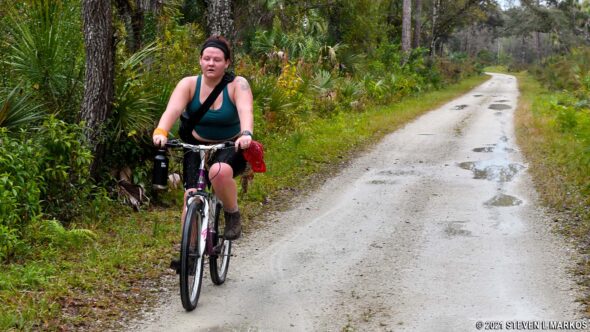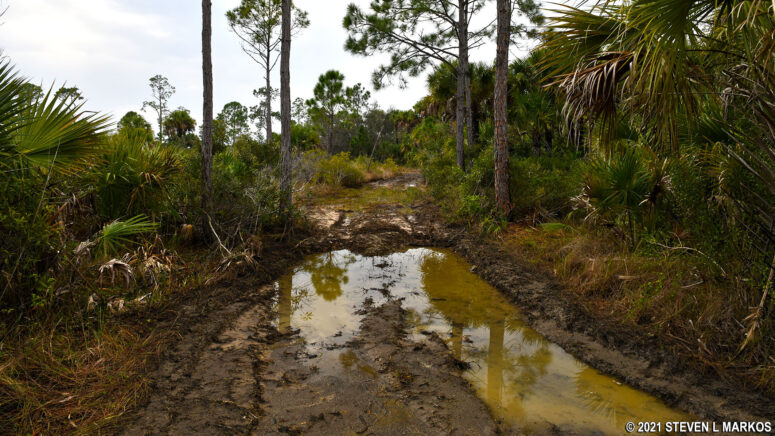See the Backcountry web page for maps to access points.
Bikes are allowed on the Fire Prairie Trail, the dirt road along the Levee 28 canal, the raised dirt road called Nobles Grade north of Mile Marker 63 on I-75 (both in the Additions Backcountry Unit), and any roads in Big Cypress National Preserve that vehicles are allowed on, both paved and dirt. In the backcountry of Bear Island, Turner River, and Corn Dance there are over 200 miles of what are essentially dirt roads known as “Primary Trails.” In the wet season (May-October) most of these are underwater, but during the dry season they are passable. Keep in mind that just because it is November 1st that the roads don’t turn dry overnight, and even during the middle of winter some roads may still be packed with mud holes that you must carry your bike around.
On a recent bike trip in Bear Island, my assistant and I got 13 miles into a 15-mile loop ride when suddenly we came to mud holes that got deeper and deeper as we waded through them. Not knowing what was up ahead, we decided to turn around and bike all the way back with the sun rapidly going down. Up to that point, other than some puddles, the roads were fine (see above photo). Keep in mind that a park Ranger told us the roads were clear, which just goes to show that nobody knows the condition of every road in the backcountry.
Primary Trails provide visitors to the park, both bikers and hikers, the opportunity to see the backcountry without the hassle of obtaining an Off-Road Driving permit (assuming you have a 4-Wheel Drive, swamp buggy, or ATV). The terrain is flat and easy to walk or bike. The only way biking could get better is if all trails were downhill both ways.
Entry by any means into the backcountry requires a permit. These are free and can be obtained at kiosks at trailheads, boat ramps, backcountry access roads, hunter check-in stations, and the visitor centers. All you need is a pen or pencil to fill out the multi-copy form on which you provide your entry date and time, your estimated return time, and the purpose of your adventure (e. g. hike, camp, hunt). Keep one copy with you, stick one in the permit collection box at the kiosk, and place one on the dashboard of your car (all backcountry access areas have parking lots or allow roadside parking). Permits help the National Park Service track which areas are used the most, plus if your car is left overnight the park Rangers will know when you were supposed to have returned, and if this time has long since passed, they know to come looking for you.
You can also download the Backcountry-Permit (PDF) and either fill it out by hand or by using Adobe Acrobat (or an Acrobat browser plug-in). The PDF has two permits, and if you use Acrobat, the second permit fills out automatically as you type information into the first permit. You need three permits, so be sure to print two copies of the PDF and then use scissors to separate the copies.

Typical Primary Road during the dry season in the Turner River Backcountry Unit of Big Cypress National Preserve
With a few exceptions, use of any photograph on the National Park Planner website requires a paid Royalty Free Editorial Use License or Commercial Use License. See the Photo Usage page for details.
Last updated on June 8, 2023






